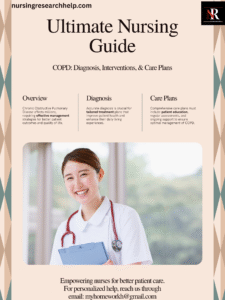The Ultimate Nursing Guide to Chronic Obstructive Pulmonary Disease (COPD): Diagnosis, Interventions, & Care Plans20245
The Ultimate Nursing Guide to Chronic Obstructive Pulmonary Disease (COPD): Diagnosis, Interventions, & Care Plans 2025

Table of Contents
- Introduction: Your Essential Guide to Mastering COPD Nursing Care
- Part 1: What is COPD? The Foundation for Your Nursing Assessment
- Part 2: The Nursing Process in Action: A Deep Dive into COPD Care
- Part 3: Putting It All Together: Crafting the Perfect COPD Nursing Care Plan
- Part 4: Beyond the Basics: Holistic and Advanced COPD Nursing Care
- Conclusion: Your Role as a COPD Champion
Introduction: Your Essential Guide to Mastering COPD Nursing Care
As a nursing student, you’ll inevitably encounter patients with Chronic Obstructive Pulmonary Disease (COPD). It’s not just another condition on your syllabus; it’s a global health crisis. According to the World Health Organization (WHO), COPD is the third leading cause of death worldwide, and your expertise will be critical in managing these patients. Are you ready to create a care plan that truly makes a difference?
The challenge is clear: COPD is a complex, progressive disease requiring a multifaceted nursing approach that goes far beyond just administering oxygen. Crafting a comprehensive COPD nursing care plan is a core skill that will be tested in your exams, on the NCLEX, and most importantly, in your daily clinical practice. It demands a deep understanding of pathophysiology, sharp assessment skills, and the ability to prioritize interventions effectively.
This guide is your one-stop resource, designed specifically for nursing students like you. We will break down everything from pathophysiology to advanced holistic interventions, providing a clear roadmap to help you excel. We’ll walk you through the complete nursing process for COPD, including formulating a precise nursing diagnosis, selecting evidence-based interventions, and building a detailed care plan example. This is your ultimate NCLEX review and clinical guide for COPD.
Part 1: What is COPD? The Foundation for Your Nursing Assessment
Before you can intervene, you must understand. This section establishes the “why” behind the nursing actions that follow, providing a concise, clinically relevant overview of COPD. A solid grasp of this foundation is the first step toward building an effective nursing care plan for COPD.
Defining a Global Health Challenge
Chronic Obstructive Pulmonary Disease (COPD) is defined as a “common, preventable, and treatable disease that is characterized by persistent respiratory symptoms and airflow limitation.” This limitation is due to airway and/or alveolar abnormalities, usually caused by significant exposure to noxious particles or gases, as outlined by the Global Initiative for Chronic Obstructive Lung Disease (GOLD) 2024 Report. It’s not a single disease but an umbrella term that primarily includes two overlapping conditions:
- Chronic Bronchitis: Characterized by a chronic productive cough, it involves inflammation and thickening of the bronchial walls and hyperplasia of mucous glands, leading to excessive mucus production.
- Emphysema: This condition involves the destruction of the alveoli (the tiny air sacs in the lungs). This damage reduces the surface area available for gas exchange and causes a loss of elastic recoil, leading to air trapping on exhalation.
For nurses, this definition is crucial. It highlights that while COPD is chronic and progressive, our interventions can significantly improve symptoms, prevent complications, and enhance a patient’s quality of life.
Pathophysiology Simplified for Nurses
Understanding the underlying pathophysiology helps you anticipate patient symptoms and rationalize your nursing interventions. In essence, COPD creates a perfect storm within the lungs:
- Inflammation:Chronic exposure to irritants (like cigarette smoke) triggers an abnormal inflammatory response in the airways and lung parenchyma.
- Airway Remodeling:This persistent inflammation leads to structural changes. The small airways narrow and thicken (bronchial wall thickening), and scar tissue can form, further obstructing airflow.
- Mucus Hypersecretion:The number and size of mucus-producing goblet cells increase, leading to the classic chronic cough and sputum production seen in chronic bronchitis.
- Alveolar Destruction:In emphysema, the walls of the alveoli are destroyed, creating larger, less effective air spaces (bullae). This reduces the surface area for gas exchange and leads to a loss of lung elasticity.
- Air Trapping:Because of narrowed airways and loss of elastic recoil, patients struggle to exhale fully. Air gets trapped in the lungs, leading to hyperinflation (the “barrel chest” appearance) and making it harder to take the next breath.
This cascade directly results in the hallmark signs of COPD: impaired gas exchange (leading to hypoxemia and hypercapnia) and an increased work of breathing.
Etiology and Key Risk Factors
While COPD is not exclusively a “smoker’s disease,” tobacco use is by far the most significant risk factor. As a nurse, your assessment must include a thorough history of exposure to these key causes:
- Cigarette Smoking: The primary cause, accounting for over 70% of COPD cases in high-income countries (WHO).
- Environmental & Occupational Exposures: Prolonged exposure to dust, chemicals, fumes, and both indoor (e.g., biomass fuel) and outdoor air pollution are major contributors.
- Genetic Factors: Alpha-1 antitrypsin (AAT) deficiency is a well-known genetic condition that predisposes individuals, even non-smokers, to developing emphysema.
- Other Factors: A history of severe or frequent respiratory infections during childhood can also increase the risk of developing COPD later in life.

Part 2: The Nursing Process in Action: A Deep Dive into COPD Care
This is the core of your clinical practice. Systematically applying the nursing process (Assessment, Diagnosis, Planning, Intervention, Evaluation) provides the structure needed to manage a complex chronic illness like COPD. Let’s walk through each step.
Comprehensive Nursing Assessment for COPD
A thorough assessment is the foundation of any great COPD nursing care plan. It involves gathering both what the patient tells you and what you can observe and measure. According to NurseTogether, this process involves collecting physical, psychosocial, and diagnostic data.
Subjective Data (What the Patient Reports)
- Dyspnea: The hallmark symptom. Ask about shortness of breath at rest, with exertion (e.g., walking to the bathroom), and how it impacts their daily activities.
- Chronic Cough: Is it persistent? Is it productive (bringing up sputum)? If so, what is the color, consistency, and amount?
- Chest Tightness: Patients may describe this as a feeling of constriction or heaviness.
- Fatigue & Activity Intolerance: A common complaint due to the increased work of breathing and poor gas exchange.
Objective Data (What You Observe & Measure)
- Respiratory Status:
- Rate & Pattern: Look for tachypnea (rapid breathing) and a prolonged expiratory phase.
- Use of Accessory Muscles: Observe for the use of neck (sternocleidomastoid, scalene) and shoulder muscles to breathe, indicating increased respiratory effort.
- Breath Sounds: Auscultate the lungs for wheezes (from narrowed airways), crackles/rhonchi (from secretions), and diminished breath sounds (from poor air movement).
- Positioning: Note if the patient assumes a “tripod” position (leaning forward with hands on knees) to ease breathing.
- General Appearance:
- Barrel Chest: An increased anterior-posterior chest diameter caused by chronic air trapping.
- Cyanosis: A bluish discoloration of the skin and mucous membranes, a late and serious sign of hypoxia.
- Peripheral Edema: Swelling in the ankles and legs can be a sign of right-sided heart failure (cor pulmonale), a complication of advanced COPD.
- Nutritional Status: Look for signs of weight loss and muscle wasting (cachexia), as the body burns many calories just to breathe.
- Vital Signs: Monitor respiratory rate, heart rate, and especially oxygen saturation (SpO2) via pulse oximetry.
Observation of accessory muscle use (Trapezius, Scalenus, Sternomastoid) is a key indicator of increased work of breathing in COPD patients
Key Diagnostic Tests & Their Nursing Implications
Your assessment also includes interpreting diagnostic data. As a nurse, you need to know what these tests mean for your patient’s care.
- Spirometry (Pulmonary Function Tests – PFTs): This is the “gold standard” for diagnosing and staging COPD. It measures how much air a patient can forcefully exhale and how quickly. A post-bronchodilator FEV1/FVC ratio of less than 70% confirms the diagnosis (Nurse.com). The FEV1 percentage then helps stage the severity according to GOLD criteria (Mild to Very Severe).
- Arterial Blood Gases (ABGs): Crucial for assessing the severity of an acute exacerbation. It provides direct measurements of oxygen (PaO2), carbon dioxide (PaCO2), and pH, revealing hypoxemia and/or hypercapnia (respiratory acidosis).
- Chest X-Ray: While not used to diagnose COPD, it helps rule out other conditions (like pneumonia or heart failure) and can show signs of hyperinflation or bullae in advanced disease.
- Sputum Culture: If an infection is suspected during an exacerbation (e.g., purulent sputum), a culture can identify the causative bacteria and guide antibiotic therapy.
- COPD Assessment Test (CAT) / mMRC Dyspnea Scale: These are simple questionnaires that help quantify the impact of COPD on a patient’s daily life and functional status, guiding therapy goals.
Spirometry is the gold standard for diagnosing COPD, where a technician monitors the patient’s forced exhalation to measure lung function

Prioritizing Problems: Key Nursing Diagnoses for COPD
After your assessment, you’ll formulate a nursing diagnosis. This is your clinical judgment about the patient’s response to their health condition. It’s the critical link between assessment and intervention. For COPD, several diagnoses are common, but these four are almost always a priority.
- Ineffective Airway Clearance
- Related to:Bronchoconstriction, increased sputum production, ineffective cough, and airway inflammation.
- As Evidenced By:Abnormal breath sounds (wheezes, rhonchi), productive cough with thick sputum, patient’s inability to clear secretions, and dyspnea.
- Impaired Gas Exchange
- Related to:Alveolar-capillary membrane changes (from emphysema), airflow limitation leading to air trapping, and ventilation-perfusion (V/Q) mismatch.
- As Evidenced By:Low oxygen saturation (SpO2 <92%), abnormal ABGs (hypoxemia, hypercapnia), dyspnea, confusion or restlessness, and cyanosis.
- Activity Intolerance
- Related to:Imbalance between oxygen supply and demand, fatigue from increased work of breathing, and deconditioning.
- As Evidenced By:Patient report of fatigue, shortness of breath with minimal exertion (e.g., walking to the kitchen), and a significant increase in heart rate or respiratory rate with activity.
- Risk for Infection
- Related to:Weakened lung defense mechanisms, retained secretions (which provide a medium for bacterial growth), and potential use of immunosuppressive medications like corticosteroids.
Setting Goals: Planning & Expected Outcomes
Once you have your nursing diagnoses, you can set patient-centered, measurable, achievable, relevant, and time-bound (SMART) goals. These goals, or expected outcomes, guide your interventions and help you evaluate their effectiveness.
“The goals of managing COPD are to reduce symptoms, prevent exacerbations, and improve quality of life.” – Nurse.com
Examples of patient goals include:
- Patient will maintain a patent airway as evidenced by clear breath sounds on auscultation and effective coughing to clear secretions by the end of the shift.
- Patient will demonstrate adequate oxygenation, maintaining an SpO2 between 88-92% (or as individually prescribed) on supplemental oxygen throughout hospitalization.
- Patient will report an improved ability to perform activities of daily living (ADLs) with less dyspnea by discharge.
- Patient will remain free from signs and symptoms of a new respiratory infection (e.g., fever, purulent sputum) during their hospital stay.
- Patient will correctly demonstrate the use of their prescribed inhaler with a spacer before discharge.
Critical Nursing Interventions for COPD Management
This is the “how-to” section—the actions you take to help your patient achieve their goals. We’ll group these evidence-based interventions by the nursing diagnosis they address.
Interventions for Ineffective Airway Clearance
- Positioning: Elevate the head of the bed (High-Fowler’s position). This uses gravity to lower the diaphragm, promoting better chest expansion and aeration of the lungs.
- Airway Clearance Techniques: Encourage controlled coughing (e.g., “huff” coughing) and deep breathing exercises. This helps mobilize and expectorate secretions.
- Hydration: Encourage adequate fluid intake (e.g., 2-3 liters per day, if not contraindicated by cardiac or renal conditions) to help thin viscous secretions, making them easier to clear.
- Medication Administration: Administer prescribed mucolytics (to thin mucus) and bronchodilators (to open airways) as ordered. Often, a bronchodilator is given before mucolytics to prevent bronchospasm.
- Suctioning: If the patient has a very weak or ineffective cough, you may need to perform nasotracheal or oropharyngeal suctioning to clear the airway, but this is an invasive measure used only when necessary.
Interventions for Impaired Gas Exchange
- Oxygen Therapy: This is a cornerstone of treatment. Administer supplemental oxygen as prescribed to maintain the target saturation level. For most COPD patients, the target SpO2 is 88-92%. This is to prevent blunting the hypoxic drive to breathe, as some patients with chronic hypercapnia rely on low oxygen levels as their primary stimulus to breathe. Monitor the patient closely for signs of respiratory depression.
- Breathing Techniques: Teach and reinforce pursed-lip breathing (inhale through the nose for 2 counts, exhale slowly through pursed lips for 4-6 counts). This technique creates back-pressure in the airways, keeping them open longer during exhalation, reducing air trapping, and relieving dyspnea. Also teach diaphragmatic (belly) breathing to reduce the work of breathing by using the diaphragm more effectively.
- Continuous Monitoring: Vigilantly monitor respiratory status, including rate, depth, effort, and SpO2. Assess for changes in mental status (like confusion or restlessness), which can be an early sign of worsening hypoxia or hypercapnia.
- Ventilatory Support: In cases of acute exacerbation with respiratory failure, be prepared to assist with non-invasive ventilation (NIV), such as BiPAP. Evidence shows that early initiation of NIV can reduce the work of breathing, improve gas exchange, and decrease the need for intubation.
Administering supplemental oxygen via a nasal cannula is a key nursing intervention to manage hypoxemia in COPD patients
Interventions for Activity Intolerance
- Energy Conservation Techniques: Teach the patient to pace activities throughout the day, take scheduled rest periods, and sit rather than stand for tasks like grooming. Help them organize their environment to keep frequently used items within easy reach.
- Pulmonary Rehabilitation: Strongly encourage participation in a multidisciplinary pulmonary rehab program. These programs are proven to improve exercise tolerance, reduce symptoms, and enhance quality of life through structured exercise training, education, and support.
- Assistive Devices: Ensure the patient has and can use assistive devices like walkers, which can reduce the energy expenditure of ambulation.
Interventions for Risk for Infection
- Prevention is Key: Promote meticulous hand hygiene for the patient, family, and staff. Strongly encourage annual influenza vaccination and pneumococcal vaccinations as recommended by the CDC.
- Monitor for Early Signs: Assess for subtle signs of infection, such as increased dyspnea, increased sputum volume, or a change in sputum color to purulent (yellow or green). Also monitor for fever and elevated white blood cell count.
- Patient Education: Teach the patient and family to recognize these early signs of an exacerbation and to seek prompt medical attention. Advise them to avoid crowds during peak flu season.
Pharmacological Interventions: A Critical Nursing Role
Your role isn’t just to give meds; it’s to ensure they are taken correctly and that the patient understands their purpose. This is a major focus of any nursing guide to Chronic Obstructive Pulmonary Disease (COPD).
- Administer and Educate: You will administer various inhaled medications. It’s vital to explain the difference between “rescue” inhalers (like short-acting beta-agonists, SABAs) and “maintenance” inhalers (like long-acting beta-agonists, LABAs, and inhaled corticosteroids, ICS).
- Master Inhaler Technique: One of the most impactful nursing interventions is teaching and observing correct inhaler technique. Many patients use their devices incorrectly, leading to poor medication delivery. Use the “teach-back” method and demonstrate the use of spacers, which improve drug deposition in the lungs.
Patient education on proper inhaler and spacer technique is a critical nursing intervention to ensure effective medication delivery
Part 3: Putting It All Together: Crafting the Perfect COPD Nursing Care Plan
Now, let’s bring all these components together into a clear, organized COPD nursing care plan. This format is exactly what you’ll need for your clinical paperwork, case studies, and to prepare for the NCLEX. Below is a sample
care plan focusing on two of the most critical nursing diagnoses for a hospitalized patient with a COPD exacerbation.
| Nursing Diagnosis | Expected Outcomes (Goals) | Nursing Interventions | Rationale | Evaluation |
| Impaired Gas Exchange related to alveolar-capillary membrane changes and airflow limitation as evidenced by SpO2 of 87% on room air, dyspnea, and patient report of “can’t catch my breath.” |
|
|
|
|
| Ineffective Airway Clearance related to excessive sputum production and bronchoconstriction as evidenced by coarse rhonchi on auscultation, ineffective cough, and production of thick, tenacious sputum. |
|
|
|
|
This example provides a strong foundation for your studies. However, every patient is unique, and your assignments often require a more detailed, personalized approach. Feeling stuck on a complex COPD case study or need help writing a top-grade nursing care plan? The expert tutors and writers at nursingresearchhelp.com can provide the guidance and support you need to succeed. Contact us today for personalized assistance!
Part 4: Beyond the Basics: Holistic and Advanced COPD Nursing Care
Excellent nursing care for COPD extends beyond the hospital bed. As a nurse, you are in a prime position to empower patients for long-term success. This involves a holistic approach that addresses education, psychosocial needs, and nutrition.
Patient & Family Education: The Cornerstone of Self-Management
Education is arguably the most critical long-term intervention. An empowered patient is less likely to be readmitted. Your teaching plan should be a central part of your COPD nursing care plan.
- Self-Management & Action Plans: Teach patients how to use a COPD Action Plan. This simple tool helps them recognize worsening symptoms (the “Yellow Zone”) and know what actions to take (e.g., increase rescue inhaler use, start prescribed steroids/antibiotics) to prevent a full-blown exacerbation requiring hospitalization (the “Red Zone”).
- Smoking Cessation: This is the single most effective intervention to slow the progression of COPD. While you may not be a cessation specialist, you can provide resources, support, and information on nicotine replacement therapy, counseling, and medications.
- Medication Adherence: As pulmonologist Dr. William Zhang notes, while therapies don’t reverse damage, preventing exacerbations maintains lung function for longer. Stress the importance of taking maintenance medications *every day*, even when feeling well.
Psychosocial Support: Addressing the Invisible Burden
Living with a chronic, breathless condition takes a significant mental and emotional toll. Research shows that anxiety, depression, and social isolation are incredibly common in patients with severe COPD. Your holistic assessment must include their psychosocial status.
- Assess and Acknowledge: Ask patients about their mood, feelings of anxiety or panic, and how the disease affects their social life. Simply acknowledging their struggle can be therapeutic.
- Provide Emotional Support: Be an active, empathetic listener. Living with COPD can be isolating. Connecting with a caring professional can make the journey less overwhelming.
- Refer and Connect: Be aware of resources. Refer patients to hospital social workers, mental health services, or patient support groups. Pulmonary rehabilitation programs also offer a great opportunity for patients to connect with others facing similar challenges.
Providing emotional support and facilitating connections are key nursing roles in addressing the psychosocial burden of COPD
Nutritional Guidance: Fueling the Work of Breathing
Many patients with advanced COPD are malnourished. The increased metabolic demand from the high work of breathing, combined with fatigue, dyspnea during eating, and medication side effects, puts them at high risk for weight loss and muscle wasting.
- Monitor Nutritional Status: Track patient weight, BMI, and lab values (like albumin).
- Implement Nutritional Strategies:
- Encourage small, frequent, high-calorie, high-protein meals to reduce fatigue and the feeling of fullness that can press on the diaphragm.
- Suggest resting before meals.
- Provide oral nutritional supplements as ordered.
- Consult with a dietician for a comprehensive nutritional plan, as recommended in guidelines for hospitalized COPD patients.
Palliative and End-of-Life Care: Enhancing Quality of Life
It’s a common misconception that palliative care is only for the last days of life. In reality, palliative care is an approach focused on symptom management and improving quality of life, and it can be initiated at any stage of a serious illness like COPD. The American Lung Association emphasizes that starting palliative care early can be beneficial.
- Focus on Symptom Relief: Palliative care teams are experts in managing difficult symptoms like severe dyspnea, pain, anxiety, and fatigue.
- Facilitate Communication: As a nurse, you play a key role in facilitating difficult but necessary conversations about goals of care and advance directives. This shared decision-making ensures that the care provided aligns with the patient’s values and wishes.
- Support for Patient and Family: Palliative care provides an extra layer of support for both the patient and their family, addressing not just physical needs but also emotional and spiritual ones. A 2025 study highlighted the importance of empowering nurses to provide this type of care (Empowering nurses to provide palliative care).
Pulmonary rehabilitation programs combine exercise, education, and support to improve quality of life and functional capacity in COPD patients
Conclusion: Your Role as a COPD Champion
COPD is a formidable challenge for patients and the healthcare system, but it is not an insurmountable one. This guide has shown that a structured nursing process—from a meticulous assessment to targeted interventions and a well-crafted care plan—is the key to improving patient outcomes. You have learned to look beyond the disease and see the person, addressing not just their physical symptoms but their educational, nutritional, and psychosocial needs as well.
Your role as a nurse is pivotal. You are the educator who empowers patients with self-management skills, the advocate who ensures their symptoms are controlled, the vigilant caregiver who spots early signs of trouble, and the compassionate professional who supports them through the emotional challenges of living with a chronic illness. By mastering the concepts in this nursing guide to Chronic Obstructive Pulmonary Disease (COPD), you are preparing to be a true champion for your patients.

